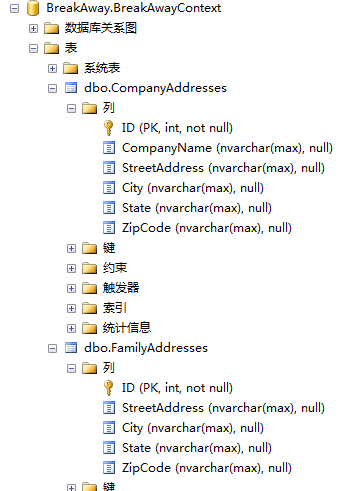为了说明什么是复杂属性,先举一个例子。
public class CompanyAddress
{
public int ID { get; set; }
public string CompanyName { get; set; }
public string StreetAddress { get; set; }
public string City { get; set; }
public string State { get; set; }
public string ZipCode { get; set; }
}
public class FamilyAddress
{
public int ID { get; set; }
public string StreetAddress { get; set; }
public string City { get; set; }
public string State { get; set; }
public string ZipCode { get; set; }
}
上面有两个类:公司地址和家庭地址,它们有四个相同的属性:StreetAddress、City、State、ZipCode。映射到数据库中的结构如图:

这里,我们可以将这四个属性集合成一个复杂属性Address,修改后的类为:
public class CompanyAddress
{
public int ID { get; set; }
public string CompanyName { get; set; }
public Address Address { get; set; }
}
public class FamilyAddress
{
public int ID { get; set; }
public Address Address { get; set; }
}
[ComplexType]
public class Address
{
public string StreetAddress { get; set; }
public string City { get; set; }
public string State { get; set; }
public string ZipCode { get; set; }
}
此时,所生成的数据库如图:

可以看到,两张表中仍然具有相应的地址属性信息。代码中的Address类就是复杂属性,它并不会在数据库中映射成相应的表,但我们的代码确简洁了许多。
所以如果有几个属性在几个类中都有用到,那么就可以将这几个属性集合成一个复杂类型,并在相应的类中增加这个复杂类型的属性。
如果我的文章对你有帮助,就点一下推荐吧.(*^__^*)
